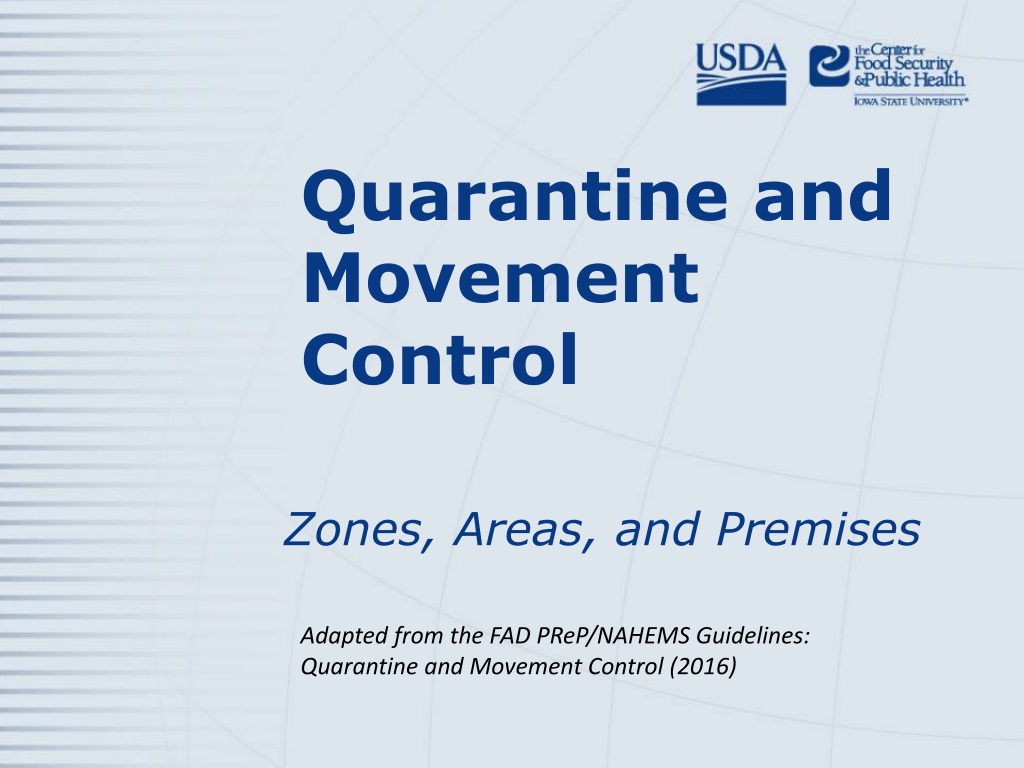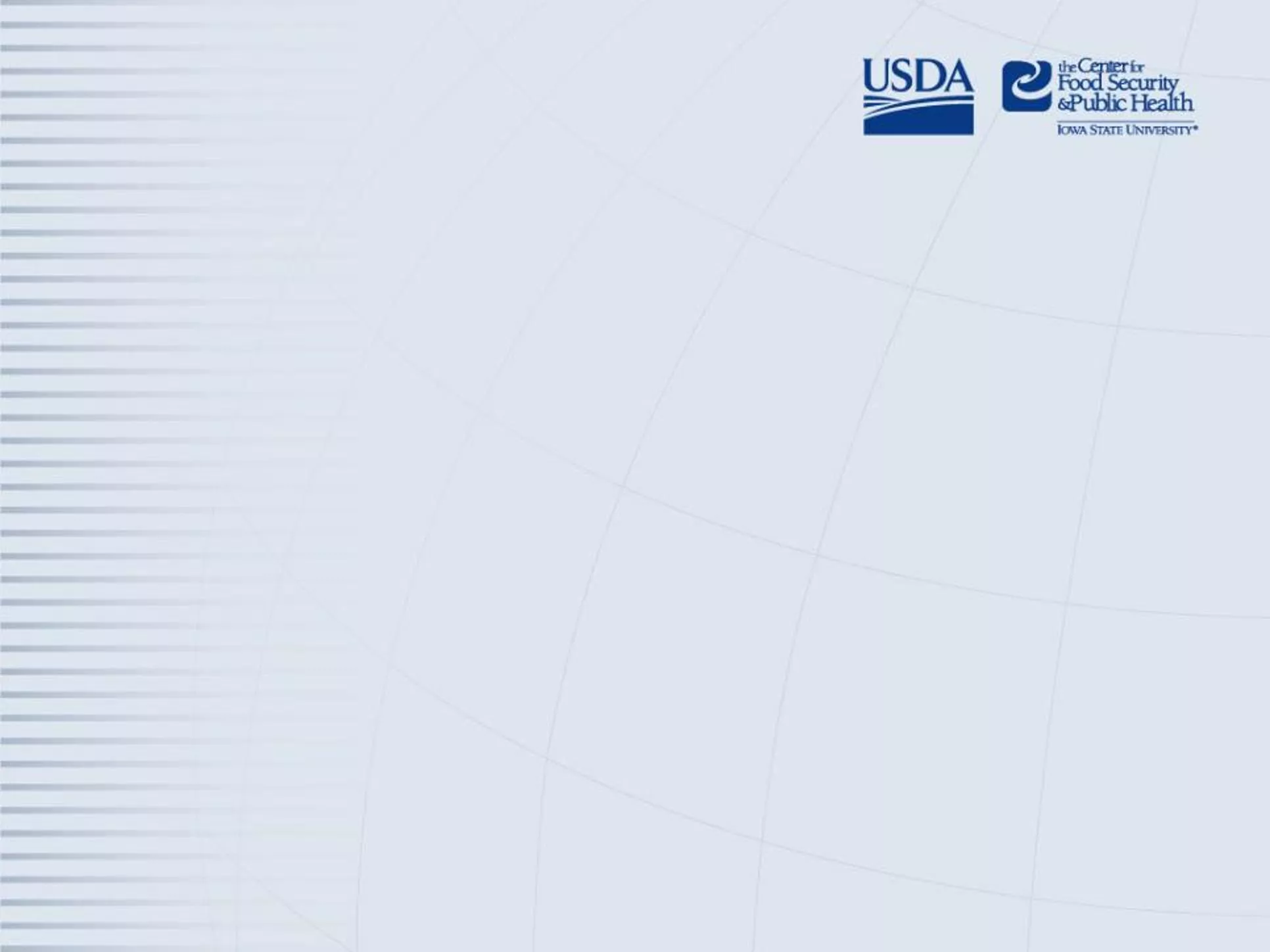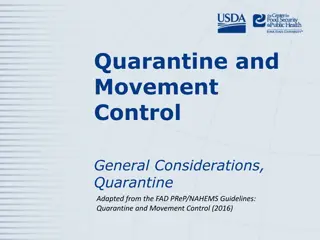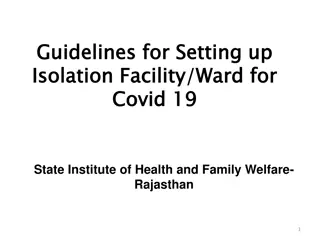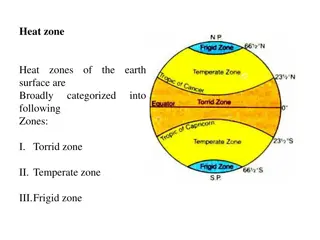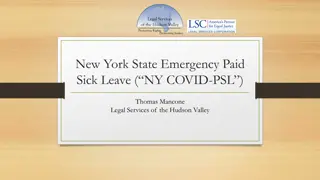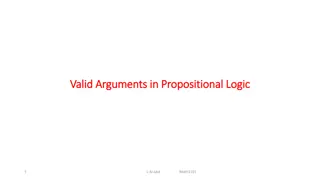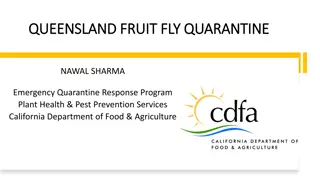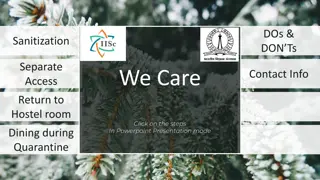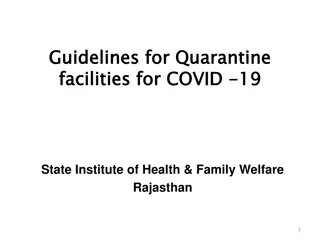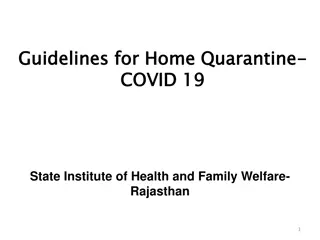Guidelines for Quarantine and Movement Control Zones and Premises
This presentation outlines the designation of zones, areas, and premises as per the FAD PReP/NAHEMS guidelines for quarantine and movement control. It covers the establishment of control areas, minimum sizes of zones, and premises designations including infected, contact, suspect, and at-risk premises. The content also explains the definitions and criteria for monitored, free, and vaccinated premises within different zones.
Download Presentation

Please find below an Image/Link to download the presentation.
The content on the website is provided AS IS for your information and personal use only. It may not be sold, licensed, or shared on other websites without obtaining consent from the author. Download presentation by click this link. If you encounter any issues during the download, it is possible that the publisher has removed the file from their server.
E N D
Presentation Transcript
Quarantine and Movement Control Zones, Areas, and Premises Adapted from the FAD PReP/NAHEMS Guidelines: Quarantine and Movement Control (2016)
This Presentation Designation of zones, areas, premises Minimum sizes of zones, areas Establishing a control area FAD PReP/NAHEMS Guidelines: Quarantine & Movement Control - Zones 2 USDA APHIS and CFSPH
Zone, Area, Premises Designations Infected Premises identified Control Area = Infected Zone + Buffer Zone Quarantines in Control Area Infected Premises Contact Premises Suspect Premises FAD PReP/NAHEMS Guidelines: Quarantine & Movement Control - Zones 3 USDA APHIS and CFSPH
Premises Designations Premises Definition Zone Infected Premises (IP) Presumptive positive case or confirmed positive case exists Infected Zone Contact Premises (CP) Premises with susceptible animals that may have been exposed to the FAD, either directly or indirectly, including but not limited to exposure to animals, animal products, fomites, or people from Infected Premises. Infected Zone, Buffer Zone Suspect Premises (SP) Premises under investigation due to the presence of susceptible animals reported to have clinical signs compatible with the FAD. This is intended to be a short-term premises designation. Infected Zone, Buffer Zone, Surveillance Zone, Vaccination Zone At-Risk Premises (ARP) Premises that have susceptible animals, but none of those susceptible animals have clinical signs compatible with the FAD. Premises objectively demonstrates that it is not an Infected Premises, Contact Premises, or Suspect Premises. At-Risk Premises seek to move susceptible animals or products within the Control Area by permit. Only At-Risk Premises are eligible to become Monitored Premises. Infected Zone, Buffer Zone FAD PReP/NAHEMS Guidelines: Quarantine & Movement Control - Zones 4 USDA APHIS and CFSPH
Premises Designations contd Premises Definition Zone Monitored Premises (MP) Premises objectively demonstrates that it is not an Infected Premises, Contact Premises, or Suspect Premises. Only At-Risk Premises are eligible to become Monitored Premises. Monitored Premises meet a set of defined criteria in seeking to move susceptible animals or products out of the Control Area by permit. Infected Zone, Buffer Zone Free Premises (FP) Premises outside of a Control Area and not a Contact or Suspect Premises. Surveillance Zone, Free Area Vaccinated Premises (VP) Premises where emergency vaccination has been performed. This may be a secondary premises designation. Containment Vaccination Zone, Protection Vaccination Zone FAD PReP/NAHEMS Guidelines: Quarantine & Movement Control - Zones 5 USDA APHIS and CFSPH
Area/Zone Designations Zone/Area Definition Infected Zone (IZ) Zone that immediately surrounds an Infected Premises. Buffer Zone (BZ) Zone that immediately surrounds an Infected Zone or a Contact Premises. Control Area (CA) Consists of an Infected Zone and a Buffer Zone. Surveillance Zone (SZ) Zone outside and along the border of a Control Area. Free Area (FA) Area not included in any Control Area. Vaccination Zone (VZ) Emergency Vaccination Zone classified as either a Containment Vaccination Zone (typically inside a Control Area) or a Protection Vaccination Zone (typically outside a Control Area). This may be a secondary zone designation. FAD PReP/NAHEMS Guidelines: Quarantine & Movement Control - Zones 6 USDA APHIS and CFSPH
Zones, Areas, Premises FAD PReP/NAHEMS Guidelines: Quarantine & Movement Control - Zones 7 USDA APHIS and CFSPH
Minimum Sizes of Zones and Areas FAD PReP/NAHEMS Guidelines: Quarantine & Movement Control - Zones 8 USDA APHIS and CFSPH
Minimum Sizes of Zones, Areas Zone or Area Minimum Size and Details Perimeter should be at least 3 km (~1.86 miles) beyond perimeters of presumptive or confirmed Infected Premises. Will depend on disease agent and epidemiological circumstances. This zone may be redefined as the outbreak continues. Infected Zone (IZ) Perimeter should be at least 7 km (~4.35 miles) beyond the perimeter of the Infected Zone. Width is generally not less than the minimum radius of the associated Infected Zone, but may be much larger. This zone may be redefined as the outbreak continues. Buffer Zone (BZ) Perimeter should be at least 10 km (~6.21 miles) beyond the perimeter of the closest Infected Premises. Please see Table 5 for factors that influence the size of the Control Area. This area may be redefined as the outbreak continues. Control Area (CA) Width should be at least 10 km (~6.21 miles), but may be much larger. Surveillance Zone (SZ) FAD PReP/NAHEMS Guidelines: Quarantine & Movement Control - Zones 9 USDA APHIS and CFSPH
Zone, Area Sizes for Mosquito, Culicoides-Borne Diseases Zone or Area Minimum Size and Details Perimeter should be at least 10 km (~6.2 miles) beyond perimeters of presumptive or confirmed Infected Premises. Will depend on disease agent and epidemiological circumstances. This zone may be redefined as the outbreak continues. Infected Zone (IZ) Perimeter should be at least 20 km (~12.4 miles) beyond the perimeter of the Infected Zone. Width is generally not less than the minimum radius of the associated Infected Zone, but may be much larger. This zone may be redefined as the outbreak continues. Buffer Zone (BZ) Perimeter should be at least 30 km (~18.6 miles) beyond the perimeter of the closest Infected Premises. Please see Table 5 for factors to consider in determining the size of a Control Area. This area may be redefined as the outbreak continues. Control Area (CA) Width should be at least 20 km (~12.4 miles) but may be larger depending on the known geographic range of vector. Surveillance Zone (SZ) FAD PReP/NAHEMS Guidelines: Quarantine & Movement Control - Zones 10 USDA APHIS and CFSPH
Considerations in Establishing a Control Area FAD PReP/NAHEMS Guidelines: Quarantine & Movement Control - Zones 11 USDA APHIS and CFSPH
Establishing a Control Area Factors Additional Details Effectiveness and efficiency of administration Multi-jurisdictional considerations: local, State, Tribal, and multistate Areas defined by geography Areas defined by distance between premises Jurisdictional areas Physical boundaries Reproductive rate Incubation period Ease of transmission Infectious dose Species susceptibility Modes of transmission (such as, fecal-oral, droplet, aerosol, vectors) Survivability in the environment Ease of diagnosis (for example, no pathognomonic signs; requires diagnostic laboratory testing) Age of lesions FAD epidemiology Number of contacts Transmission pathways and transmission risk o Extent of animal movement o Number of animals o Species of animals o Age of animals o Movement of traffic and personnel to and from premises (fomite spread) o Biosecurity measures in place at time of outbreak Infected Premises characteristics FAD PReP/NAHEMS Guidelines: Quarantine & Movement Control - Zones 12 USDA APHIS and CFSPH
Establishing a Control Area contd Factors Additional Details Movement of traffic (fomites) and personnel to and from premises (fomite spread) Biosecurity measure in place prior to outbreak Number and types of premises Susceptible animal populations and population density Animal movements Contact Premises characteristics Types of premises in area or region Land use in area or region Prevailing winds Humidity Susceptible wildlife and population density Wildlife as biological or mechanical vectors Environment Climate (for aerosol spread diseases) Biosecurity practices in place prior to outbreak Biosecurity practices implemented once outbreak detected General area, region, or agricultural sector biosecurity Types of premises, animal movements, and network of animal and fomite movements Number of backyard or transitional premises COB plans and processes in place or activated at beginning of outbreak (such as surveillance, negative diagnostic tests, premises biosecurity, and risk-assessments) Permit processes, memorandums of understanding, and information management systems in place or activated at beginning of outbreak Continuity of business FAD PReP/NAHEMS Guidelines: Quarantine & Movement Control - Zones 13 USDA APHIS and CFSPH
For More Information FAD PReP/NAHEMS Guidelines: Quarantine and Movement Control http://www.aphis.usda.gov/fadprep Quarantine and Movement Control web-based training module http://naherc.cfsph.iastate.edu/ FAD PReP/NAHEMS Guidelines: Quarantine & Movement Control - Zones 14 USDA APHIS and CFSPH
Guidelines Content Authors (CFSPH) Janice P. Mogan, DVM Heather Allen, PhD, MPA Kristen Bretz, MS Reviewers (USDA) Randall Crom, DVM (Retired) Jonathan Zack, DVM FAD PReP/NAHEMS Guidelines: Quarantine & Movement Control - Zones 15 USDA APHIS and CFSPH
Acknowledgments Development of this presentation was by the Center for Food Security and Public Health at Iowa State University through funding from the USDA APHIS Veterinary Services PPT Authors: Janice Mogan, DVM; Logan Kilburn Reviewers: Kristen Bretz, MS
